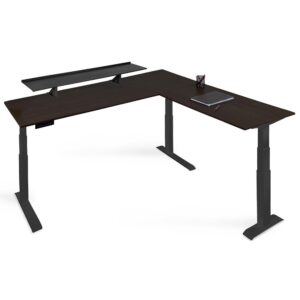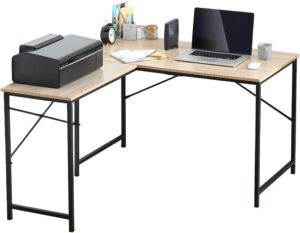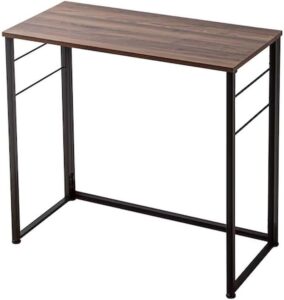Choosing between an L-shaped desk vs straight desk isn’t just about style or looks. It plays a big role in how comfortable and productive you are each day. If you’re living in Japan, especially in a smaller apartment, every piece of furniture must earn its place. Desks are no exception. With remote work now a normal part of life, the right desk can shape your day more than you think.
This article helps you decide which desk works better for your space, lifestyle, and job. We’ll compare the benefits, trade-offs, and real use cases for both types of desks while keeping Japan’s unique housing situation in mind.
- What Is an L-Shaped Desk?
- What Is a Straight Desk?
- Why This Matters for Remote Workers in Japan
- Pros and Cons: L-Shaped Desk
- Pros and Cons: Straight Desk
- Price Ranges in Japan
- What Kind of Work Do You Do?
- What Fits Best in a Japanese Apartment?
- Desk Positioning and Noise Control
- Storage and Add-On Options
- Product Picks (Available in Japan)
- Tips to Improve Any Desk Setup
- Questions to Ask Before You Buy
- Final Verdict: L-Shaped Desk vs Straight
What Is an L-Shaped Desk?

- Made of two connected surfaces forming a right angle
- Often placed in a room corner
- Designed to give more workspace across two sides
- Separates tasks like writing and computer use easily
What Is a Straight Desk?

- Simple rectangular design
- Fits along any wall or even in the center of a room
- Ideal for one main task at a time
- Easier to move and reposition when reorganizing
Why This Matters for Remote Workers in Japan
Working from home in Japan is different from other countries. Apartments are compact, and homes prioritize space-saving features. Choosing the wrong desk can lead to daily frustration. A desk that’s too large may overwhelm the room. A desk that’s too small may limit your productivity.
In Japan, many homes have multipurpose spaces. Your dining room might also be your office. That means your desk needs to be functional but also fit visually with your living area.
Most apartments in Tokyo, Osaka, or Nagoya fall between 25–60 m². In such tight quarters, the way you position and use your desk can make or break your work setup.
Pros and Cons: L-Shaped Desk
Pros
- Makes Corners Useful: Puts otherwise unused areas to work
- More Work Surface: You can keep devices, notebooks, and tools within reach
- Divided Work Zones: One side for typing, one for writing or meetings
- Cable Friendly: Easier to hide wires across multiple devices
- Visual Balance: Can make a room look more organized if paired with shelves
Cons
- Large Footprint: Hard to fit in small or oddly shaped rooms
- Heavy and Bulky: Difficult to move when cleaning or rearranging
- More Expensive: Costs more due to size and complexity
- Assembly Time: Often comes with more parts and setup effort
Pros and Cons: Straight Desk
Pros
- Small-Space Friendly: Works in 1K or even studio apartments
- Lightweight: Easy to reposition or store when needed
- Lower Cost: Great for budget-conscious setups
- Simple Style: Blends well with any interior
- Quick Setup: Fewer parts, faster to build
Cons
- Less Surface Area: May not fit multiple monitors or devices
- Limited Storage: Needs add-ons for drawers or shelves
- Single Task Focus: Not ideal for multitaskers or creatives
Price Ranges in Japan
| Desk Type | Average Price Range (JPY) |
|---|---|
| L-Shaped Desk | ¥20,000 – ¥90,000 |
| Straight Desk | ¥10,000 – ¥50,000 |
Popular retailers include Amazon Japan, Nitori, Muji, and Rakuten. Most straight desks are cheaper and easier to ship. L-shaped models may require scheduled delivery and extra shipping fees.
What Kind of Work Do You Do?
Creative Professionals
If you’re a designer, video editor, or architect, the L-shape gives you space to spread out. You can keep drawing tools on one side and your computer setup on the other. This helps maintain flow without switching tools constantly.
Tech Workers and Developers
You may not need tons of space, but you do need clarity. A straight desk with a clean design is often perfect. Pair it with an ergonomic chair and monitor arm for a tidy and efficient coding environment.
Writers, Teachers, and Consultants
Writing or video calls don’t require much physical gear. A simple desk with one monitor, a webcam, and a keyboard is enough. Straight desks work well here, keeping distractions low.
Gamers and Streamers
A two-monitor setup, lighting gear, and microphone? Go for an L-shape. You’ll need room for hardware and still want some space left for drinks or notes.
Parents and Freelancers
If you’re balancing work with family duties, an L-shaped desk lets you turn slightly to a different task. That small shift—just a 90-degree turn—can help you mentally switch roles.
What Fits Best in a Japanese Apartment?
| Apartment Type | Avg. Size (sq. meters) | Desk Fit Recommendation |
|---|---|---|
| 1K | 13–18 m² | Straight desk, wall placement |
| 1LDK | 25–35 m² | Either, based on layout |
| 2LDK | 40–60 m² | L-shape possible, especially in corner setups |
Also consider ceiling height and nearby outlets. Some newer apartments have raised floors with built-in cable paths. Use them if available to avoid wire clutter.
Desk Positioning and Noise Control
Japanese walls are often thin. Choose a desk location that limits sound travel. Facing a wall reduces echo during meetings. Avoid placing your desk right next to a bedroom if others are home during your work hours.
L-shaped desks can be placed facing inward to create a nook. Straight desks offer more flexibility if you need to change locations often.
Add felt pads under desk legs. This reduces noise when moving and helps protect your flooring.
Storage and Add-On Options
L-Shaped Desk Accessories
- Side drawers for files
- Under-desk CPU holders
- Corner shelf risers for extra screen elevation
- LED strips under the desk for soft lighting
Straight Desk Accessories
- Clamp-on monitor stands
- Hanging desk drawers
- Clip-on cup holders and headphone hooks
- Rolling carts for under-desk storage
Add a vertical bookshelf nearby for both styles. It keeps items close without cluttering your main workspace.
Product Picks (Available in Japan)
L-Shaped Desks
IRIS OHYAMA L-Shaped Desk

- Reliable Japanese brand with solid construction
- Ideal for corner setups with included cable trays
- View on Amazon Japan
Sanwa Supply L-Shaped Desk

- Sleek minimalist design with wide under-desk space
- Great for dual-monitor setups
- View on Amazon Japan
Straight Desks
Nitori Folding Desk

- Perfect fit for compact apartments
- Simple, smooth finish with durable materials
- View on Amazon Japan
LOWYA Compact Desk

- Modern design with color options
- Easy to style and fit with home decor
- View on Amazon Japan
Check Amazon Japan reviews before purchasing. Look at ratings for build quality and ease of assembly. Some listings also include video instructions that can help during setup.
Tips to Improve Any Desk Setup
- Choose a chair with lumbar support and breathable fabric
- Use a vertical monitor for reading-heavy tasks
- Add a footrest for better leg posture
- Mount a power strip to the underside of the desk
- Hang wall hooks for headphones or bags
A tidy desk boosts mental clarity. Keep only what you need on the surface.
Questions to Ask Before You Buy
- How many devices will I use daily?
- Do I need more space now or will I need it in the future?
- Is my space permanent, or will I move soon?
- How much storage do I need right at the desk?
- Does my chair fit well with this desk height?
Take measurements first. Double-check room layouts before ordering. Japanese delivery services are fast, but returns can be inconvenient.
Final Verdict: L-Shaped Desk vs Straight
- Choose an L-shaped desk if you multitask often, use many tools, or want clear work zones
- Choose a straight desk if you’re tight on space, prefer minimal setups, or value flexibility
For remote workers in Japan, the right desk makes a huge difference. It’s more than furniture—it’s your daily base of operations.
Think beyond looks. Match your desk to your tasks, your space, and your habits.
Still organizing your home office? Browse our guides on chairs, lighting, and soundproofing to build your ideal work zone in Japan.


